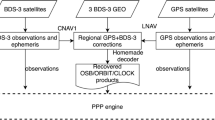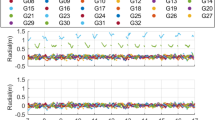Abstract
With the development of China’s BeiDou Navigation Satellite System (BDS) and the operation of the real-time service (RTS) of the International GNSS service, BDS real-time precise point positioning (RTPPP) has become possible. In this contribution, the RTS product CLK93 is employed for BDS RTPPP, and its quality for BDS orbit and clock corrections is first assessed by availability and accuracy over a period of 24 days. Following this, the convergence time and positioning accuracy of BDS-only RTPPP are evaluated by performing a 24-day processing with ten stations from the multi-GNSS experiment (MGEX) network. Finally, a real-time kinematic test is conducted in an urban environment to further investigate the performance of BDS-only RTPPP. Experimental results show that the average availabilities of the CLK93 corrections are approximately 95% for the inclined geosynchronous satellite orbit (IGSO) satellites, 90% for the medium earth orbit (MEO) satellites and 65% for the geostationary earth orbit satellites. The mean accuracy of the real-time corrections, which is represented by the signal-in-space ranging error (SISRE) value, is 10 cm for the IGSO and MEO satellites. Furthermore, the average positioning accuracies in the north, east and up components of the ten MGEX stations are approximately 1.7, 2.2 and 2.6 cm, respectively, for the static mode and 10.3, 15.6 and 29.2 cm, respectively, for the kinematic mode. In addition, the average time required to converge to a 20-cm accuracy in the three-dimensional component is approximately 100 and 136 min for BDS-only RTPPP in the static and kinematic modes, respectively. In addition, the positioning accuracy of BDS-only RTPPP in the real-time kinematic test is 0.86, 0.92 and 1.68 m in the east, north and up components, respectively, for the whole solutions during the test, which is obviously worse than that obtained by GPS-only RTPPP.










Similar content being viewed by others
References
Abdi N, Ardalan AA, Karimi R, Rezvani MH (2017) Performance assessment of multi-GNSS real-time PPP over Iran. Adv Space Res 59(12):2870–2879
Boehm J, Niell A, Tregoning P, Schuh H (2006) Global Mapping Function (GMF): a new empirical mapping function based on numerical weather model data. Geophys Res Lett 33(7):L07304
Cai C, Gao Y, Pan L, Zhu J (2015) Precise point positioning with quad-constellations: GPS, BeiDou, GLONASS and Galileo. Adv Space Res 56(1):133–143
China Satellite Navigation Office (CSNO) (2017) BeiDou navigation satellite system signal in space interface control document: open service signal B1C (version 1.0). http://www.beidou.gov.cn/xt/gfxz/201712/P020171226741342013031.pdf
Elsobeiey M, Al-Harbi S (2016) Performance of real-time Precise Point Positioning using IGS real-time service. GPS Solut 20(3):565–571
Ge M, Gendt G, Rothacher M, Shi C, Liu J (2008) Resolution of GPS carrier-phase ambiguities in precise point positioning (PPP) with daily observations. J Geod 82(7):389–399
Geng J, Li X, Zhao Q, Li G (2018) Inter-system PPP ambiguity resolution between GPS and BeiDou for rapid initialization. J Geod. https://doi.org/10.1007/s00190-018-1167-6
Guo J, Geng J (2018) GPS satellite clock determination in case of inter-frequency clock biases for triple-frequency precise point positioning. J Geod 92(10):1133–1142
Guo F, Li X, Zhang X, Wang J (2017a) The contribution of Multi-GNSS Experiment (MGEX) to precise point positioning. Adv Space Res 59(11):2714–2725
Guo F, Li X, Zhang X, Wang J (2017b) Assessment of precise orbit and clock products for Galileo, BeiDou, and QZSS from IGS Multi-GNSS Experiment (MGEX). GPS Solut 21(1):279–290
Kazmierski K, Sośnica K, Hadas T (2018a) Quality assessment of multi-GNSS orbits and clocks for real-time precise point positioning. GPS Solut 22:11–23. https://doi.org/10.1007/s10291-017-0678-6
Kazmierski K, Hadas T, Sośnica K (2018b) Weighting of multi-GNSS observations in real-time precise point positioning. Remote Sens 10(1):84–99
Kouba J, Héroux P (2001) Precise point positioning using IGS orbit and clock products. GPS Solut 5(2):12–28
Li M, Qu L, Zhao Q, Guo J, Su X, Li X (2014) Precise point positioning with the BeiDou navigation satellite system. Sensors 14(1):927–943
Liu Y, Ye S, Song W, Lou Y, Chen D (2017) Integrating GPS and BDS to shorten the initialization time for ambiguity-fixed PPP. GPS Solut 21(2):333–343
Lu C, Chen X, Liu G, Dick G, Wickert J, Jiang X, Zheng K, Schuh H (2017) Real-time tropospheric delays retrieved from multi-GNSS observations and IGS real-time product streams. Remote Sens 9(12):1317–1319
Montenbruck O, Steigenberger P, Hugentobler U, Teunissen P, Nakamura S (2013) Initial assessment of the COMPASS/BeiDou-2 regional navigation satellite system. GPS Solut 17(2):211–222
Montenbruck O, Steigenberger P, Khachikyan R, Weber G, Langley RB, Mervart L, Hugentobler U (2014) IGS-MGEX: preparing the ground for multi-constellation GNSS science. Inside GNSS 9(1):42–49
Montenbruck O, Steigenberger P, Hauschild A (2015) Broadcast versus precise ephemerides: a multi-GNSS perspective. GPS Solut 19(2):321–333
Pan Z, Chai H, Kong Y (2017) Integrating multi-GNSS to improve the performance of precise point positioning. Adv Space Res 60(12):2596–2606
Petit G, Luzum B (eds), IERS Conventions (2010) (IERS technical note No. 36). Verlag des Bundesamts für Kartographie und Geodäsie, Frankfurt am Main, Germany
RTCM (2016) RTCM standard 10403.3 differential GNSS (global navigation satellite systems) services-version 3. RTCM special committee no. 104. October 7
Saastamoinen J (1972) Atmospheric correction for the troposphere and stratosphere in radio ranging satellites. In: Use of artificial satellites for geodesy, vol 15, no 6, pp 247–251
Takasu T, Yasuda A (2009) Development of the low-cost RTK-GPS receiver with an open source program package RTKLIB. In: International symposium on GPS/GNSS, Seogwipo-si Jungmundong, Korea, November 4–6
Wang L, Li Z, Ge M, Neitzel F, Wang Z, Yuan H (2018a) Validation and assessment of multi-GNSS real-time precise point positioning in simulated kinematic mode using IGS real-time service. Remote Sens 10(22):337–356
Wang Z, Li Z, Wang L, Wang X, Yuan H (2018b) Assessment of multiple GNSS real-time SSR products from different analysis centers. ISPRS Int J Geo-Inf 7(3):85–105
Wanninger L, Beer S (2015) BeiDou satellite-induced code pseudorange variations: diagnosis and therapy. GPS Solut 19(4):639–648
Weber G, Mervart L, Lukes Z, Rocken C, Dousa J (2007) Real-time clock and orbit corrections for improved point positioning via NTRIP. In: Proceedings of the ION GNSS 2007, Institute of Navigation, Fort Worth, Texas, USA, September 25–28, 1992–1998
Wu JT, Wu SC, Hajj GA, Bertiger WI, Lichten SM (1992) Effects of antenna orientation on GPS carrier phase. Astrodynamics 76(18):1647–1660
Zumberge JF, Heflin MB, Jefferson DC, Watkins MM, Webb FH (1997) Precise point positioning for the efficient and robust analysis of GPS data from large networks. J Geophys Res Solid Earth 102(B3):5005–5017
Acknowledgements
This work was partially funded by the National Key Research Program of China “Collaborative Precision Positioning Project” (No. 2016YFB0501905), the National Natural Science Foundation of China (41674043, 41704038), the Beijing Nova Program (xx2017042), Beijing Talents Foundation (2017000021223ZK13) and the CAS Pioneer Hundred Talents Program. The first author is very grateful for the financial support from the China Scholarship Council for a research stay at Technische Universität Berlin with Prof. Dr. Neitzel as his host. In addition, thanks also to BKG for providing the real-time data streams and to IGS, CNES and GFZ for providing the precise products.
Author information
Authors and Affiliations
Corresponding author
Additional information
Publisher's Note
Springer Nature remains neutral with regard to jurisdictional claims in published maps and institutional affiliations.
Rights and permissions
About this article
Cite this article
Wang, L., Li, Z., Ge, M. et al. Investigation of the performance of real-time BDS-only precise point positioning using the IGS real-time service. GPS Solut 23, 66 (2019). https://doi.org/10.1007/s10291-019-0856-9
Received:
Accepted:
Published:
DOI: https://doi.org/10.1007/s10291-019-0856-9




